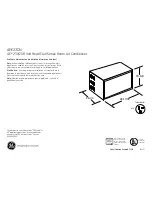
Unit Startup
RT-SVX24J-EN
167
Full Modulating Gas Furnace
Full Modulating gas heaters are available for the 850, 1100,
1800, 2500 MBH heater sizes.
– The firing rate of the 850 MBH modulating heater
can vary from 10% to 100% of the 850 MBH.
– The firing rate of the 1100, 1800 and 2500 MBH can
vary from 5% to 100% of it's nameplate value.
Heat Exchanger
The heat exchanger drum, tubes and front and rear
headers are constructed from stainless steel alloys.
Unit Control
The unit is controlled by a supply air temperature sensor
located in the supply air stream for VAV units. CV units
have two sensors, one located in the supply air stream and
the zone sensor.The temperature sensor signal is sent to
the Heat module of the IntelliPak™ II Unit Control. The
control signal from the Heat Module signal is directly
proportional 0-10 VDC. The higher the voltage signal, the
lower the call for heat.
The 0-10 VDC signal controls the air damper actuator
which is mounted on the end of the air damper shaft. As
the actuator rotates clockwise, more combustion air
passes through the combustion air blower. In turn, the gas
butterfly valve opens more through a directly connected
linkage, resulting in a higher rate of firing.
1.
Use
Table 37, p. 110
to program the following system
components for operation by scrolling through the
Human Interface displays;
Gas Heat
Supply Fan (On)
Variable Frequency Drive (100% Output, if applicable)
RTM Occ/Unocc Output (Unoccupied)
High Fire (90%)
Turn the 115 volt control circuit switch 4S24 located in
the heater control panel to the “On” position.
Open the manual gas valve, located in the gas heat
section.
2. Once the configuration for the appropriate heating
system is complete, press the NEXT key until the LCD
displays the “Start test in __Sec.” screen. Press the +
key to designate the delay before the test is to start.
This service test will begin after theTEST START key is
pressed and the delay designated in this step has
elapsed. Press the ENTER key to confirm this choice.
3. Press theTEST START key to start the test. Remember
that the delay designated in step 2 must elapse before
the system will begin to operate.
4. Once the system has started, check the appearance of
the flame through the sight glass provided on the front
of the heat exchanger. In appearance, a normal flame
has a clearly defined shape, and is primarily (75%) blue
in color with an orange tip.
5. Check the inlet gas pressure at the modulating gas
valve. The inlet pressure should be 6" to 8" w.c.
6. Use a carbon dioxide analyzer and measure the
percentage of carbon dioxide in the flue gas. Refer to
the illustration in
Figure 117, p. 167
. Take several
samples to assure that an accurate reading is obtained.
The C0
2
level should fall in the ranges shown in the
guide values
Table 48, p. 166
Figure 117. Flue gas carbon dioxide and oxygen
measurements
Figure 118. High/low pressure regulator
WARNING
Rotating Components!
During installation, testing, servicing and
troubleshooting of this product it may be necessary to
work with live and exposed rotating components. Have
a qualified or licensed service individual who has been
properly trained in handling exposed rotating
components, perform these tasks. Failure to follow all
safety precautions could result in rotating components
cutting and slashing technician which could result in
death or serious injury.
Содержание SEHJ090-162
Страница 40: ...Dimensional Data 40 RT SVX24J EN Figure 13 Evaporative condenser water connection locations RIGHT SIDE VIEW ...
Страница 48: ...Installation 48 RT SVX24J EN Figure 18 Ductwork conversion ...
Страница 58: ...Installation 58 RT SVX24J EN Figure 36 5 Connected tubes 6 install panels Connected tubes 5 6 ...
Страница 75: ...Installation RT SVX24J EN 75 Figure 51 Hot water coil piping Figure 52 Steam coil piping ...
Страница 87: ...Installation RT SVX24J EN 87 Figure 57 Typical field wiring diagram for 90 to 162 ton CV control options ...
Страница 89: ...Installation RT SVX24J EN 89 Figure 59 Typical field wiring diagram for 90 to 162 ton VAV control options ...
















































